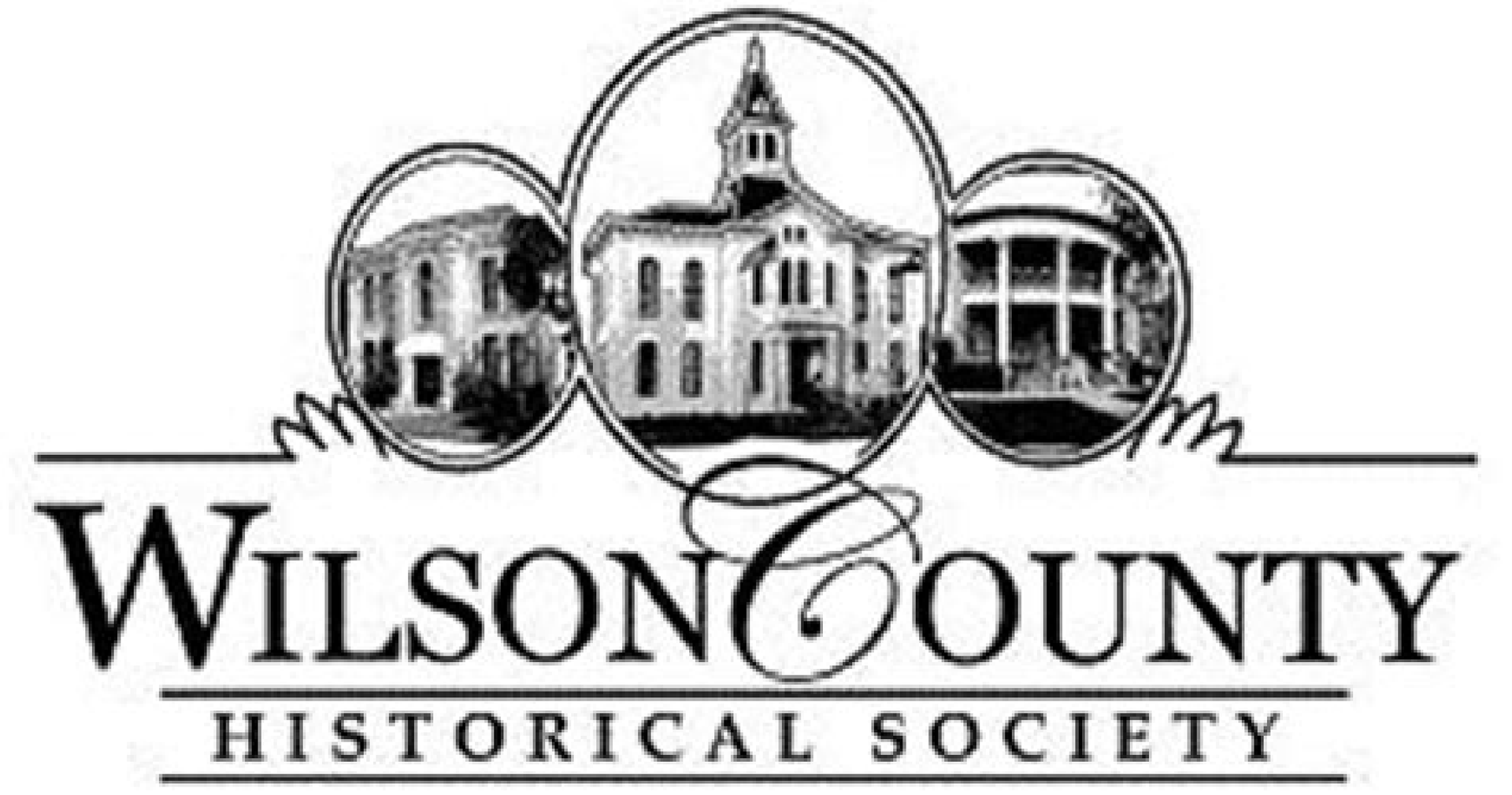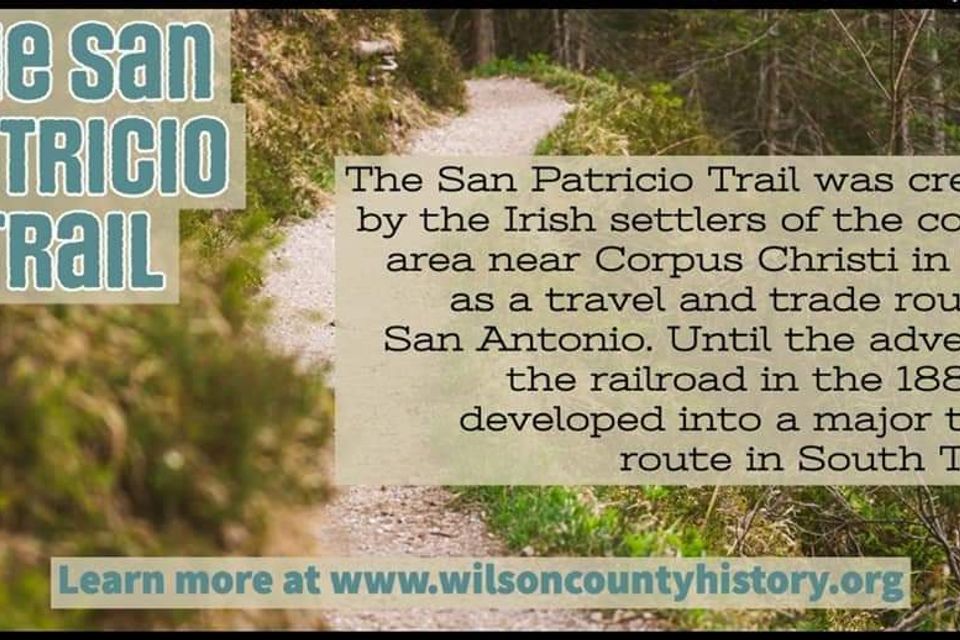by Barbara J. Wood
SAN PATRICIO TRAIL
THE SAN PATRICIO TRAIL
THE SAN PATRICIO TRAIL ...... compiled by Wilson County Historian Gene Maeckel.
The San Patricio Trail was created by the Irish settlers of the coastal area near Corpus Christi in 1830 as a travel and trade route to San Antonio. Until the advent of the railroad in the 1880s it developed into a major travel route in South Texas. The trail in the San Antonio area began at Graytown near the Bexar – Wilson county boundary. At this time Graytown was a crossroads point for several roads and trails which provided
multiple access routes into San Antonio. Located near Graytown was the Maldonado Crossing or ford site to cross the San Antonio River. Nearby there was also a ferry crossing. This crossing enabled travelers to reach San Antonio on either its west side to the Villa de Bexar or to its east side to the Presidio.
From Graytown the trail followed a southerly route to Fairview, Tordilla Mound and Oakville in Live Oak County. Here the road split with one route going to Corpus Christi and the other to Brownsville and Matamoras, Mexico. The road left Wilson County in the area where the three counties of Wilson, Karnes, and Atascosa joined together in the vicinity of the Tordilla Hills.
In this area was Tordilla Mound, one of the first communities in Atascosa County to have a post office, it being located just as a short distance past the Wilson County Lines. Near here also was Rock Spring, a natural water hole assuring travelers along the trail of a sure water source. Rock spring was the only reliable source of water between Graytown and Oakville. The location of Rock Spring was near Tordilla Hill, a major
landmark and prominent high point in the Tordilla Hills which was visible for miles. Later in the 1970s this local area was disturbed by quarrying operations to supply base metals
for new roadways and railroad extensions in the nearby areas. Today the water flow from Rock Spring has ceased and is no longer a natural reliable source of water.
Leaving Oakville, the trail followed the Nueces River to San Patricio then on to Corpus Christi. A second branch of the trail left Oakville going towards Brownsville.
After the Texas Revolution the San Patricio Trail had limited use because of the unsettled conditions between Texas and Mexico. The area became lawless and a refuge for criminals and wanted individuals making travel through this unprotected area unsafe.
During the United States and Mexico war, the trail returned to very active use. General Zachary Taylor used it very extensively during the war to move troops and supplies in
support of the military activities in action against Mexico. After military action ended, the trail began to be used as a route for wagons to transport goods from Corpus Christi
through San Patricio to San Antonio. Later, in the 1850s a stage line was established to carry passengers between San Antonio and Corpus Christi or Brownsville. To protect
travelers along the route, the U. S. Government established Fort Merrill on the Nueces River thirty miles upstream from San Patricio. This military base provided protectionfrom marauding Indians in addition to the number of lawless individuals attempting to escape justice in South Texas.
With the advent of the American Civil War, the San Patricio Trail became a major thoroughfare for the South's war effort. The Union had blockaded all the ports along the Gulf Coast. The Confederacy used the trail to reach the Mexican port of Matamores to trade with foreign countries. This trade included the exchange of cotton for military supplies. Large amounts of arms and ammunition were obtained in this manner for the war effort.
After the American Civil War ended, the trail was again used by wagons to transport goods to and from South Texas. Until 1881, the trail was also used for stage coach travel and postal service.
Stage stops along this route in Wilson County were at Fairview and the Tordilla area. In the 1870s a stage stop was established at the Roundtree Ranch headquarters just west
of the Wilson County and Atascosa County Line. This stop provided a livery stable and a rest stop for the stagecoach passengers. It later became the only stage stop between
Oakville and Fairview. Stages operated daily between San Antonio and Corpus Christi. At Oakville, this stage line interconnected with another stage line going to and from
Brownsville.
Compiled by Gene Maeckel from archives of the Wilson County Historical Society. 7/20/09
******************************
Gene Maeckel of Poth, Texas, passed away peacefully at home surrounded by family on Thursday, Nov. 18, 2021. He was born and raised in Poth where he graduated from Poth High School.
Gene Maeckel was relentless in his quest to preserve Wilson County history. He loved every aspect of the county's history and he was always happy to share. Like every good historian, for him history was an ongoing discussion, a quest for new knowledge. When it came to history, Gene was everywhere, always promoting Wilson County's unique history. He is sorely missed! ( Allen Kosub )
THE SAN PATRICIO TRAIL
The San Patricio Trail was created by the Irish settlers of the coastal area near Corpus Christi in 1830 as a travel and trade route to San Antonio. Until the advent of the railroad in the 1880s it developed into a major travel route in South Texas. The trail in the San Antonio area began at Graytown near the Bexar – Wilson county boundary. At this time Graytown was a crossroads point for several roads and trails which provided multiple access routes into San Antonio. Located near Graytown was the Maldonado
Crossing or ford site to cross the San Antonio River. Nearby there was also a ferry crossing. This crossing enabled travelers to reach San Antonio on either its west side to the Villa de Bexar or to its east side to the Presidio.
From Graytown the trail followed a southerly route to Fairview, Tordilla Mound and Oakville in Live Oak County. Here the road split with one route going to Corpus Christi and the other to Brownsville and Matamoras, Mexico. The road left Wilson County in the area where the three counties of Wilson, Karnes, and Atascosa joined together in the vicinity of the Tordilla Hills. In this area was Tordilla Mound, one of the first communities in Atascosa County to have a post office, it being located just as a short distance past the Wilson County Lines. Near here also was Rock Spring, a natural water hole assuring travelers along the trail of a sure water source. Rock spring was the only reliable source of water between Graytown and Oakville. The location of Rock Spring was near Tordilla Hill, a major landmark and prominent high point in the Tordilla Hills which was visible for miles. Later in the 1970s this local area was disturbed by quarrying operations to supply base metals for new roadways and railroad extensions in the nearby areas.Today the water flow from Rock Spring has ceased and is no longer a natural reliable source of water.
Leaving Oakville, the trail followed the Nueces River to San Patricio then on to Corpus Christi. A second branch of the trail left Oakville going towards Brownsville.
After the Texas Revolution the San Patricio Trail had limited use because of the unsettled conditions between Texas and Mexico.The area became lawless and a refuge for criminals and wanted individuals making travel through this unprotected area unsafe.
During the United States and Mexico war, the trail returned to very active use. General Zachary Taylor used it very extensively during the war to move troops and supplies in
support of the military activities in action against Mexico. After military action ended, the trail began to be used as a route for wagons to transport goods from Corpus Christi
through San Patricio to San Antonio. Later, in the 1850s a stage line was established to carry passengers between San Antonio and Corpus Christi or Brownsville. To protect
travelers along the route, the U. S. Government established Fort Merrill on the Nueces River thirty miles upstream from San Patricio. This military base provided protectionfrom marauding Indians in addition to the number of lawless individuals attempting to escape justice in South Texas.
With the advent of the American Civil War, the San Patricio Trail became a major thoroughfare for the South's war effort. The Union had blockaded all the ports along the Gulf Coast. The Confederacy used the trail to reach the Mexican port of Matamores to trade with foreign countries. This trade included the exchange of cotton for military supplies. Large amounts of arms and ammunition were obtained in this manner for the war effort.
After the American Civil War ended, the trail was again used by wagons to transport goods to and from South Texas. Until 1881, the trail was also used for stage coach travel and postal service.
Stage stops along this route in Wilson County were at Fairview and the Tordilla area. In the 1870s a stage stop was established at the Roundtree Ranch headquarters just west
of the Wilson County and Atascosa County Line. This stop provided a livery stable and a rest stop for the stagecoach passengers. It later became the only stage stop between
Oakville and Fairview. Stages operated daily between San Antonio and Corpus Christi. At Oakville, this stage line interconnected with another stage line going to and from
Brownsville.
Compiled by Gene Maeckel from archives of the Wilson County Historical Society. 7/20/09


